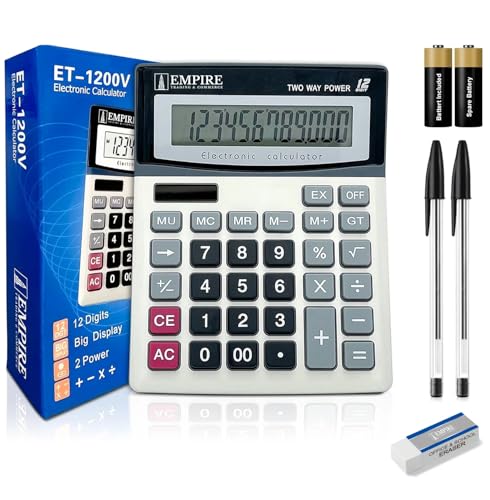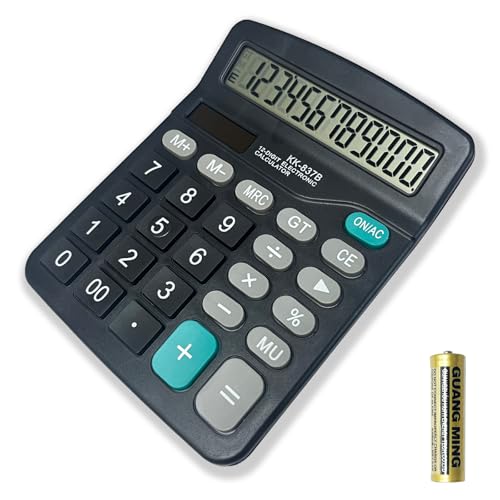Understanding Non-Programmable Calculators: What They Are and How They Work
Defining Non-Programmable Calculators
Non-programmable calculators are straightforward devices designed for basic arithmetic calculations. Unlike programmable calculators, which allow users to input custom calculations and scripts, non-programmable calculators focus on performing standard functions such as addition, subtraction, multiplication, and division. They are generally easier to use, making them ideal for students and individuals who only require basic calculations.
How They Function
These calculators have a simple interface with numerical keys and operational buttons. When we press a series of numbers and operations, the calculator processes the inputs and displays the result on a screen. The internal mechanisms are designed to handle the logic of mathematical calculations but do not support advanced functions like graph plotting or complex equations. Understanding this functionality helps us appreciate their utility in everyday situations—such as quick calculations during shopping or for basic homework.
Key Features to Look For: Choosing the Right Non-Programmable Calculator for Your Needs
Display Type and Clarity
When selecting a non-programmable calculator, we should consider the display quality. A clear and readable screen makes a significant difference, especially in low-light situations or for those of us with vision challenges. Look for calculators with LCD displays that are large enough to show multiple digits clearly.
Key Layout
The layout and size of the keys are also vital. For effective use, especially if we tend to make mistakes while typing, the buttons should be of a good size and spaced out enough to prevent accidental presses. Scanning for models that have tactile feedback helps ensure we know when a button has been pressed.
Battery Life
Battery life is another important factor. We want a calculator that can last for a long time without needing frequent battery replacements. Most non-programmable calculators run on standard batteries, so checking the battery life ratings can save us from interruptions.
Additional Functionality
Some non-programmable calculators come with extra features like memory functions, which allow us to store and recall previous calculations. Other calculators may include functions for percentage calculations, square roots, and more, which can enhance our calculation experience without complicating usage.
Top Non-Programmable Calculators on the Market: Our Recommendations
Budget-Friendly Options
For those on a tight budget, models like the Casio fx-260 Solar or the Texas Instruments TI-503 SV offer reliable functionality and durability without breaking the bank. They cover all basic arithmetic functions, making them perfect for students.
Mid-Range Choices
If we’re looking for something with a bit more functionality, consider the Casio FX-991EX. It provides additional features such as fraction calculations and a higher-resolution display, making it a great choice for high school students and professionals alike.
Premium Selections
For those seeking advanced options, the Canon F718SGA is an excellent choice. While still classified as a non-programmable calculator, it includes more complex functions like tax and invoice calculations—perfect for small business owners or those managing personal finances.
How to Use Your Non-Programmable Calculator Effectively: Tips and Tricks
Familiarising Ourselves with the Calculator
Getting to know our calculator is vital for using it effectively. Spending a few minutes familiarising ourselves with the button layout and understanding what each function does can save a lot of time later, especially during critical calculations like exams.
Utilising Memory Functions
If our calculator has memory functions, we should make the most of them. These features can help us carry intermediate results, so rather than writing numbers down, we can store them and refer back as needed. This can be especially useful when working on multi-step problems.
Regular Practice
Finally, regular practice is key to becoming efficient. The more we use a non-programmable calculator, the more proficient we become at quickly entering data and interpreting results. Using our calculator for daily tasks can enhance our comfort level, ensuring we get the most from its functionality.
Maintaining Your Non-Programmable Calculator: Keeping It in Top Shape
Clean and Care
Keeping the calculator clean is essential for optimal use. Regularly wiping down the surface with a soft cloth helps prevent the build-up of dirt that can interfere with button presses. We should also avoid exposing it to liquids, as spills can damage the electronics inside.
Battery Maintenance
To enhance battery longevity, we should remove the batteries if the calculator is not in use for an extended period. This prevents leakage and potential damage. Choosing calculators with energy-efficient designs can also prolong battery life.
Storing Safely
When storing our calculator, it’s best to keep it in a protective case if possible. This protects it from accidental drops or scratches, extending its life and reliability. A designated spot in our bags or desks helps ensure we know where it is when we need it.



















